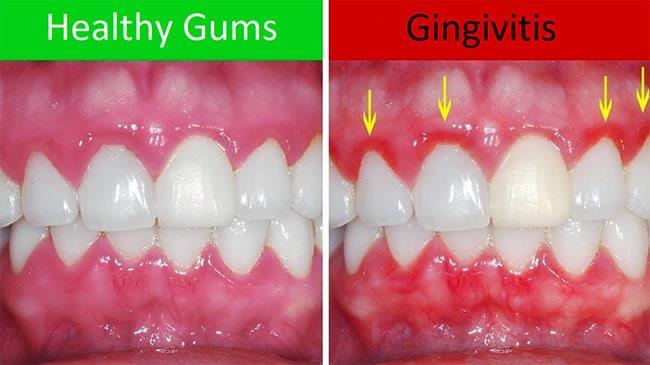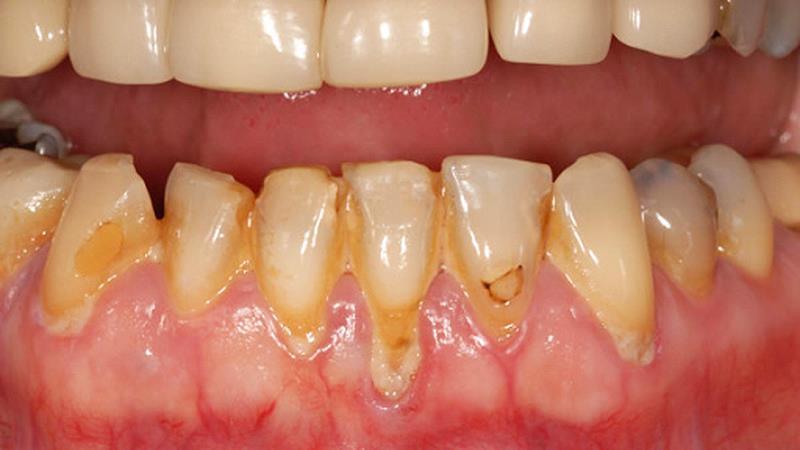Gum Disease Fact Sheet
Gum Disease
This fact sheet is designed to help you understand the two most common forms of gum disease: gingivitis and periodontitis.
Gingivitis is a reversible disease of the gums. When plaque, caused by bacteria, is left on the teeth near the gums, your body responds in an adverse manner, resulting in an inflammatory response. Your gums may appear red, swollen and tender. With proper care and oral hygiene, gingivitis is 100% reversible. If not managed correctly, gingivitis can progress to the much more serious condition known as periodontal disease. Brushing, flossing and visiting your dentist are the most important steps you can take to avoid gingivitis.

Periodontal disease is a severe and irreversible form of gum disease. Like gingivitis, periodontal disease is an inflammatory response to plaque and calculus (calcified plaque) left on your teeth. Unlike gingivitis, periodontal disease involves the bone that supports the teeth in your jaw. If left unmanaged this will result in “pocketing” around these teeth, bone will be lost and it can lead to teeth loosening and eventually needing to be extracted. **

Signs and Symptoms
- Bleeding gums whilst brushing and flossing your teeth
- Bad breath or bad taste in your mouth
- Redness and swelling of the gums around your teeth
- Receding gums
- Sensitive teeth
- Loose teeth
Treatment
The treatment for gingivitis is relatively simple. With regular dental checks and cleans and correct brushing and flossing techniques, gingivitis can be cleared within weeks.
The severity of your periodontal disease will dictate the treatment. Most dentists will treat mild to moderate periodontal disease. On occasion, you may be sent to a Periodontist for specialised treatment. Treatment involves removing calculus from the surfaces of the tooth in a process called debridement. This will often be performed under local anaesthetic for your comfort. This process may require several appointments for optimal results. Treatment should not be postponed. After treatment it is common for your teeth to become more sensitive; a desensitising toothpaste will help relieve these symptoms. You may also notice that your gums are receding, and your teeth appear to be longer, this is a positive response as it means the gums are responding to treatment. You will notice your gums return to a nice pink colouration as the gingival tissue returns to health.
Transmission
Gum disease is a result of plaque forming on your teeth. If this plaque is left on your teeth it can calcify and turn into calculus (tartar). Calculus can build up above (supragingival) or below (subgingival) your gum line, and it cannot be removed with regular toothbrushing and flossing. Once calculus is present on your teeth you can no longer remove the plaque efficiently and a dentist is required to clean your teeth.
Poorly shaped fillings, partial dentures, crowns and bridges can make it difficult to remove plaque and can also trap plaque in undesired areas.
Some conditions can make an existing gum disease worse (e.g. pregnancy, diabetes, immune disorders, HIV). Smoking also contributes to the progression of gum disease and may camouflage the condition, making diagnosis more difficult.
Prevention
Due to its irreversible nature, prevention of periodontal disease is the key to the management of this disease. Brushing and flossing daily is imperative for removing plaque from the tooth surfaces.
Visiting your dental professional for regular check-ups and cleans is also essential for the diagnosis and management of these conditions.
If you are concerned or have any questions regarding gum disease please don’t hesitate to give our friendly team a call on 07 5442 7556, we are happy to answer any of your questions.

